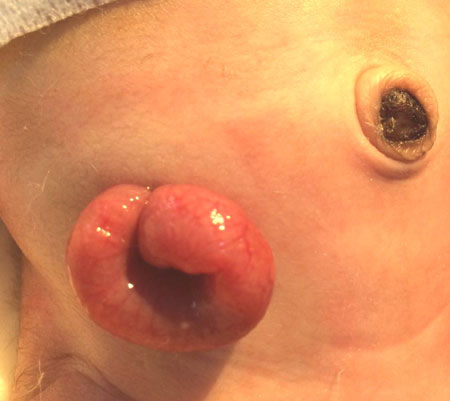Intra-abdominal drainage following routine abdominal
surgery continues to be a controversial subject [1]. The evisceration of
various organs through drain site has been commonly reported in adults
but is rarely seen in neonates. We report a case of small bowel loop
evisceration out of the drain site in a 9-day-old neonate who was
operated for duodenal atresia.
A newborn boy was admitted to the neonatal intensive
care unit (NICU) of this hospital because of antenatal detected double
bubble appearance in antenatal ultrasound of mother. At birth, the child
weighed 2275 g and appeared vigorous, with normal spontaneous
respiration. X-ray abdomen showed double bubble appearance in
upper abdomen. Gastrograffin dye study confirmed the diagnosis of
duodenal atresia. On day-2 of life, laparotomy was performed and
duodeno-duodenostomy was done. An abdominal glove drain was brought out
through a right iliac fossa stab incision approximately 8 mm. The
intraoperative course was uneventful and child was shifted back to
Neonatal medical unit. The patient responded well in the postoperative
period. Feeding was started gradually from 5th post operative day. The
drain was removed on the sixth postoperative day. On the 7th post
operative
day, a loop of
small bowel prolapsed through the drain site while he was crying (Fig.1).
The child was shifted to operation theater. The prolapsed gut through
the drainage site was healthy, slightly congested. It was reduced after
enlarging the wound, and the drain site was closed with few interrupted
absorbable sutures. The patient recovered well and was discharged on
11th postoperative day.
 |
|
Fig.1 Prolapse of gut through the
drain site.
|
Drain site gut prolapse after abdominal surgery is a
rare complication of drain insertion [2]. Increased morbidity and
mortality have been noted in patients with drain site hernia, especially
if strangulation of the loops of bowel sets in [3]. Other complications
include drain site sepsis, bleeding from abdominal wall vessels, kinking
and knotting of drains, and incisional hernia. Most reported cases of
gut evisceration involved a drain site with an external diameter of
greater than 10 mm. Predisposing factors for herniation through a drain
site include general debility, increased intra-abdominal pressure and
steroid administration [4]. The recommendations to reduce the risk of
prolapse or hernia include use of drains measuring less than 10 mm in
external diameter, use of "Z" insertion method, and making a
purse-string for closure of the defect after removal of the drain [5].
Drains are not a substitute for good surgical
techniques and must be used with caution. Careful insertion, and regular
post-operative and post-removal inspection is recommended.
References
1. Moss JP. Historical and current perspective on
surgical drainage. Surg Gynecol Obstet. 1981;152:517-27.
2. Kulkarni S, Krijgsman B, Sharma D, Kaisary AV.
Incarcerated small bowel hernia through drain site. Ann R Coll Surg
Engl. 2004;86:24-5.
3. Warble Jr J. Small bowel incarceration in a drain
site hernia. N Engl J Med. 1986;83:181-2.
4. Lee R, Raftery AT. Evisceration of small bowel at
the site of an intra abdominal drain. A complication of steroid therapy.
Br J Clin Pract. 1982;36:282-3.
5. Joong JY, Seung HL, Byung KA, Sung UB. Strangulated small bowel
hernia through a drain site. J Korean Surg Soc. 2007;73:447-8.

